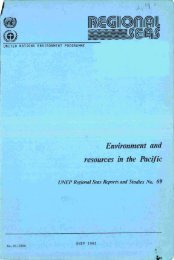FLORACIONES ALGALES NOCIVAS EN EL CONO SUR AMERICANO
FLORACIONES ALGALES NOCIVAS EN EL CONO SUR AMERICANO
FLORACIONES ALGALES NOCIVAS EN EL CONO SUR AMERICANO
Create successful ePaper yourself
Turn your PDF publications into a flip-book with our unique Google optimized e-Paper software.
<strong>FLORACIONES</strong> <strong>ALGALES</strong> <strong>NOCIVAS</strong> <strong>EN</strong> <strong>EL</strong> <strong>CONO</strong> <strong>SUR</strong> <strong>AMERICANO</strong><br />
Sar, E.A., M.E. Ferrario & B. Reguera<br />
Instituto Español de Oceanografía, 2002<br />
sobre sondas moleculares o sobre clasificadores<br />
mediante sistemas ópticos de inteligencia artificial<br />
(redes neurales) que añadidos a los sistemas de boya<br />
con ordenador acoplado, permitirían detectar desde<br />
tierra, de forma instantánea, la aparición de especies<br />
problema en distintas estaciones y/o profundidades<br />
de la columna de agua. No hay que olvidar que estos<br />
grandes avances nos informarán sobre qué organismo<br />
está presente, pero no sobre su contenido de toxinas.<br />
El instrumento perfecto sería aquél que combinara<br />
la detección morfológica o genética del organismo,<br />
en continuo, con el uso de sondas que reaccionaran<br />
con las toxinas contenidas en las células.<br />
Ya hay expertos trabajando por conseguir este objetivo,<br />
pero es obvio que el refinamiento de esta alta<br />
tecnología y su aplicación rutinaria en investigación y<br />
programas de seguimento precisará aún de años de<br />
desarrollo y validación en condiciones de campo. En<br />
cualquier caso, estas técnicas constituirán valiosos<br />
apoyos pero nunca podrán substituir la valiosa labor<br />
de los taxónomos convencionales.<br />
Mi agradecimiento a Yolanda Pazos por su crítica constructiva<br />
y por la revisión minuciosa de este artículo.<br />
BIBLIOGRAFIA<br />
Akselman, R., J.I. Carreto & N.G. Montoya, 1998.<br />
Gymnodinium catenatum and autumn toxicity in<br />
northern shelf waters of Argentina. In Reguera, B., J.<br />
Blanco, M.L. Fernández & T. Wyatt (eds.), Harmful<br />
Algae. Xunta de Galicia and IOC of UNESCO<br />
Publishers: 122-123.<br />
Alveal, K., M.E. Ferrario, E.C. Oliveira & E. Sar, 1995. Manual<br />
de Métodos Ficológicos. Universidad de Concepción,<br />
Chile, 863 pp.<br />
Anónimo, 1992. Panel Intergubernamental COI-FAO sobre<br />
Floraciones de Algas Nocivas (IOC-FAO/IPHAB-<br />
I/3), París, 23-25 de junio de 1992. Comisión<br />
Oceanográfica Intergubernamental de la UNESCO. Informes<br />
de los Órganos Rectores y de los Órganos Subsidiarios<br />
Principales, 62 pp.<br />
Anónimo, 1994. COI- Primer Taller Regional de Planificación<br />
Científica sobre Floraciones Algales Nocivas en<br />
Sudamérica. COI, UNESCO. Informes de Reuniones de<br />
Trabajo Nº 101.<br />
Anónimo, 1995. COI- Segundo Taller Regional de Planificación<br />
Científica sobre Floraciones Algales Nocivas<br />
en Sudamérica. COI, UNESCO. Informes de Reuniones<br />
de Trabajo Nº 123.<br />
Anónimo, 2001. Report of the ICES/IOC Working Group<br />
on Harmful Algal Blooms Dynamics. International<br />
Council for the Exploration of the Sea, C.M./C:04, Ref.<br />
ACME.<br />
49<br />
Arévalo, F.F., M. Bermúdez de la Puente & C. Salgado,<br />
1998. ASP toxicity in scallops: individual variability and<br />
tissue distribution. In Reguera, B., J. Blanco, M.L.<br />
Fernández & T. Wyatt (eds.), Harmful Algae. Xunta de<br />
Galicia and IOC of UNESCO Publishers: 499-502.<br />
Avaria, S., 1979. Red tides off the coast of Chile. In Taylor,<br />
D.L. & H.H. Seliger (eds.), Toxic Dinoflagellate Blooms.<br />
Elsevier, Amsterdam: 161-164.<br />
Bagoien, E., A. Miranda, B. Reguera & J.M. Franco, 1996.<br />
Effects of two PSP-producing dinoflagellates on the<br />
harpacticoid copepod Euterpina acutifrons Norman.<br />
Mar. Biol. 126: 361-369.<br />
Bates, S.S., C.J. Bird, A.S.W. De Freitas, R. Foxall, M. Gilgan,<br />
L.A. Hanic, G.R. Johnson, A.W. Mcculloch, P. Odense,<br />
R. Pocklington, M.A. Quilliam, P.G. Sim, J.C. Smith, D.V.<br />
Subba Rao, E.C.D. Todd, J.A. Walter & J.L.C. Wright,<br />
1989. Pennate diatom Nitzschia pungens as the primary<br />
source of domoic acid, a toxin in shellfish from Eastern<br />
Prince Edward Island, Canada. Can. J. Fish. Aquat. Sci.<br />
46: 1203-1215.<br />
Bell, G.R., 1961. Penetration of spines from a marine diatom<br />
into the gill tissue of lingcod (Ophion elongatus).<br />
Nature 192: 279-280.<br />
Benavides, H., L. Prado, S. Díaz & J.I. Carreto, 1995. An<br />
excepcional bloom of Alexandrium catenella in the<br />
Beagle Channel, Argentina. In Lassus, P., G.Arzul, E.<br />
Erard-Le Denn, P. Gentien & C. Marcaillou-LeBaut<br />
(eds.), Harmful Marine Algal Blooms. Lavoisier, Paris:<br />
113-119.<br />
Blanco, J. & M.J. Campos, 1988. The effect of water<br />
conditioned by a PSP producing dinoflagellate on the<br />
growth of four algal species used as food for<br />
invertebrates. Aquaculture 68: 289-298.<br />
Blanco, J., M.L. Fernández, J. Mariño, B. Reguera, A.<br />
Míguez, J. Maneiro, E. Cacho & A. Martínez, 1995. From<br />
Dinophysis spp. toxicity to DSP outbreaks: A<br />
preliminary model of toxin accumulation in mussels. In<br />
Lassus, P., G.Arzul, E. Erard-Le Denn, P. Gentien & C.<br />
Marcaillou-LeBaut (eds.), Harmful Marine Algal<br />
Blooms. Lavoisier, Paris: 777-782.<br />
Blanco, J., A. Moroño, Y. Pazos, J. Maneiro & J. Mariño,<br />
1998. Trends and variations of the abundance of main<br />
PSP and DSP producing species in the Galician Rías:<br />
environmental and biological influences. In: Reguera,<br />
B., J. Blanco, M.L. Fernández & T. Wyatt (eds.), Harmful<br />
Algae. Xunta de Galicia and IOC of UNESCO<br />
Publishers: 204-207.<br />
Bricelj, V.M. & S.E. Shumway, 1998. Paralytic shellfish toxins<br />
in bivalve molluscs: occurrence, transfer kinetics, and<br />
biotransformation. Rev. Fish. Sci. 6 (4): 315-383.<br />
Burkholder, J.M., E.J. Noga, C.W. Hobbs, H.B. Jr. Glasgow<br />
& S.A. Smith, 1992. New “phantom” dinoflagellate is<br />
the causative agent of major estuarine fish kills. Nature<br />
358: 407-410.<br />
Carreto, J.I. & H. R. Benavides, 1993. World record of PSP<br />
in Southern Argentina. Harmful Algae News 5, IOC of













![R]€@lll](https://img.yumpu.com/7594335/1/175x260/reurlll.jpg?quality=85)

